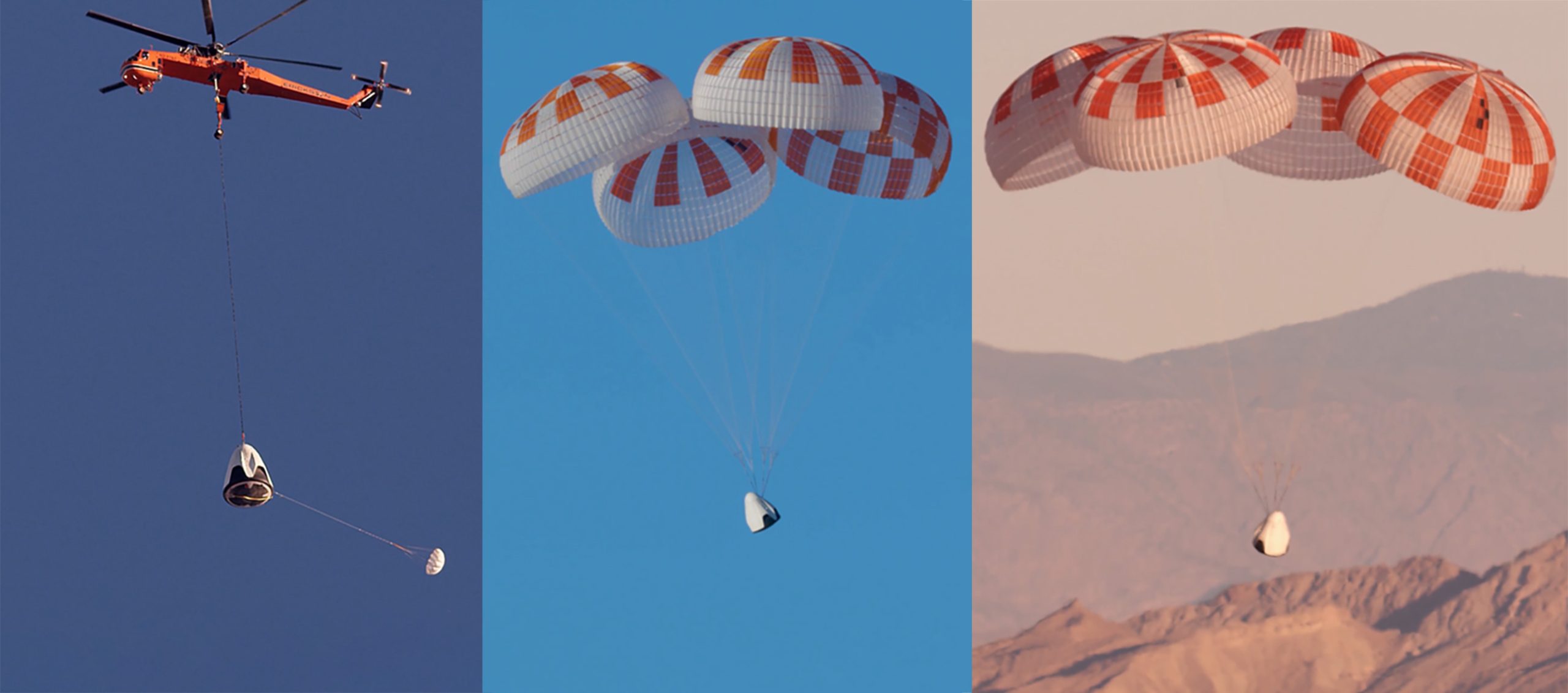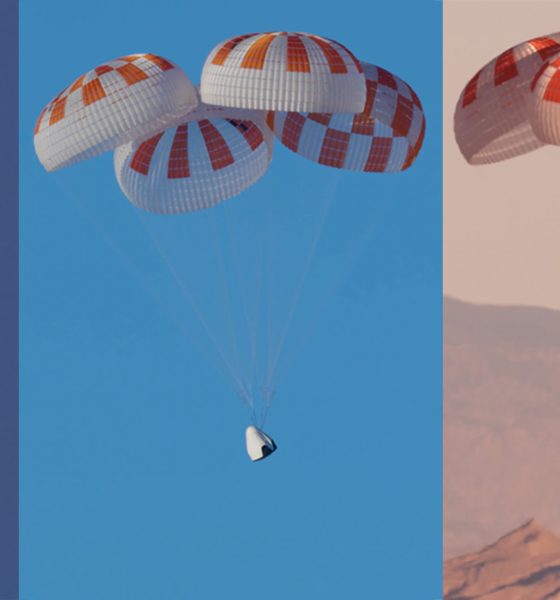

News
SpaceX’s Crew Dragon is pushing the envelope of parachute engineering, says NASA
On September 17th, a NASA blog post praised the progress SpaceX has made with Crew Dragon’s parachute system, indicating that the company is actually pushing the state of the art forward with improved modeling after dozens of tests.
Both before and after SpaceX completed Crew Dragon’s flawless March 2019 orbital launch debut, both NASA and the agency’s Aerospace Safety Advisory Panel (ASAP) have relentlessly focused on two main concerns: Falcon 9’s COPVs and Crew Dragon’s parachutes. The reasoning behind that focus is logical but may pose some problems.
Assuming that discussion points raised during quarterly ASAP and NASA Advisory Council (NAC) meetings are an accurate external representation of NASA’s internal Commercial Crew Program (CCP) priorities, the space agency has been focused on parachutes and COPVs for years. This is primarily a result of NASA’s notoriously reactive approach to safety: SpaceX suffered two COPV-related Falcon 9 failures in 2015 and 2016 and has experienced an unknown number (likely 1-3) of anomalies during Crew Dragon parachute testing.
As a result, NASA has focused extensively on these two stand-out concerns. To an extent, this is reasonable – if you know things have a tendency to fail, you’re going to want to make sure that they don’t. However, prioritizing reactive safety measures at the cost of proactive safety would be a major risk, akin to getting in a car crash because you didn’t use a turn signal and then prioritizing turn signal use so much that you forget to look both ways before making turns. Sure, you will probably never get in the same crash, but you are raising the risk of new kinds of accidents if you overcorrect your attention distribution.
NASA infamously suffered from this throughout the Space Shuttle program, analyzing known-quantities into oblivion as systematic organizational failures and glaring (but new) design flaws were either ignored or buried until it was far too late. It’s impossible to say if NASA is repeating this apparently deep-seated organizational error with Commercial Crew – only the technical experts at SpaceX and NASA have the data to accurately judge. It can be said with certainty, however, that the space agency (and its advisory panels) completely failed to predict the failure mode(s) that caused an April 20th Crew Dragon explosion that would have almost certainly killed all aboard, all while COPVs and parachutes continue(d) to be the apparent focus.
Pushing the envelope of parachute design
Qualms aside, NASA’s September 17th blog does serve as a unique look into the benefits that the space agency’s prioritization of the obvious – for better or for worse – is producing. According to NASA, the incredibly extensive testing SpaceX has had to do to satisfy agency requirements has lead the company to develop “a better understanding of how to safely design and operate parachute clusters”. SpaceX has reportedly completed 48 distinct parachute tests, of which one or two apparently failed.

In response to the additional testing and analysis NASA required after a recent April 2019 test failure, SpaceX has essentially been forced to push the state of the art of parachute design and modeling to new levels. NASA says that SpaceX has begun to model certain conditions and newfound failure modes in ways that “provide a better understanding of parachute reliability” and have forced NASA to reevaluate its own standards and certification processes. Shown in the video above, SpaceX recently completed a successful second attempt of its failed April 2019 parachute test, a major step towards confirming that the new parachute analysis and design have mitigated prior faults.
Check out Teslarati’s Marketplace! We offer Tesla accessories, including for the Tesla Cybertruck and Tesla Model 3.

News
Tesla FSD fleet is nearing 7 billion total miles, including 2.5 billion city miles
As can be seen on Tesla’s official FSD webpage, vehicles equipped with the system have now navigated over 6.99 billion miles.

Tesla’s Full Self-Driving (Supervised) fleet is closing in on almost 7 billion total miles driven, as per data posted by the company on its official FSD webpage.
These figures hint at the massive scale of data fueling Tesla’s rapid FSD improvements, which have been quite notable as of late.
FSD mileage milestones
As can be seen on Tesla’s official FSD webpage, vehicles equipped with the system have now navigated over 6.99 billion miles. Tesla owner and avid FSD tester Whole Mars Catalog also shared a screenshot indicating that from the nearly 7 billion miles traveled by the FSD fleet, more than 2.5 billion miles were driven inside cities.
City miles are particularly valuable for complex urban scenarios like unprotected turns, pedestrian interactions, and traffic lights. This is also the difference-maker for FSD, as only complex solutions, such as Waymo’s self-driving taxis, operate similarly on inner-city streets. And even then, incidents such as the San Francisco blackouts have proven challenging for sensor-rich vehicles like Waymos.
Tesla’s data edge
Tesla has a number of advantages in the autonomous vehicle sector, one of which is the size of its fleet and the number of vehicles training FSD on real-world roads. Tesla’s nearly 7 billion FSD miles then allow the company to roll out updates that make its vehicles behave like they are being driven by experienced drivers, even if they are operating on their own.
So notable are Tesla’s improvements to FSD that NVIDIA Director of Robotics Jim Fan, after experiencing FSD v14, noted that the system is the first AI that passes what he described as a “Physical Turing Test.”
“Despite knowing exactly how robot learning works, I still find it magical watching the steering wheel turn by itself. First it feels surreal, next it becomes routine. Then, like the smartphone, taking it away actively hurts. This is how humanity gets rewired and glued to god-like technologies,” Fan wrote in a post on X.
News
Tesla starts showing how FSD will change lives in Europe
Local officials tested the system on narrow country roads and were impressed by FSD’s smooth, human-like driving, with some calling the service a game-changer for everyday life in areas that are far from urban centers.

Tesla has launched Europe’s first public shuttle service using Full Self-Driving (Supervised) in the rural Eifelkreis Bitburg-Prüm region of Germany, demonstrating how the technology can restore independence and mobility for people who struggle with limited transport options.
Local officials tested the system on narrow country roads and were impressed by FSD’s smooth, human-like driving, with some calling the service a game-changer for everyday life in areas that are far from urban centers.
Officials see real impact on rural residents
Arzfeld Mayor Johannes Kuhl and District Administrator Andreas Kruppert personally tested the Tesla shuttle service. This allowed them to see just how well FSD navigated winding lanes and rural roads confidently. Kruppert said, “Autonomous driving sounds like science fiction to many, but we simply see here that it works totally well in rural regions too.” Kuhl, for his part, also noted that FSD “feels like a very experienced driver.”
The pilot complements the area’s “Citizen Bus” program, which provides on-demand rides for elderly residents who can no longer drive themselves. Tesla Europe shared a video of a demonstration of the service, highlighting how FSD gives people their freedom back, even in places where public transport is not as prevalent.
What the Ministry for Economic Affairs and Transport says
Rhineland-Palatinate’s Minister Daniela Schmitt supported the project, praising the collaboration that made this “first of its kind in Europe” possible. As per the ministry, the rural rollout for the service shows FSD’s potential beyond major cities, and it delivers tangible benefits like grocery runs, doctor visits, and social connections for isolated residents.
“Reliable and flexible mobility is especially vital in rural areas. With the launch of a shuttle service using self-driving vehicles (FSD supervised) by Tesla in the Eifelkreis Bitburg-Prüm, an innovative pilot project is now getting underway that complements local community bus services. It is the first project of its kind in Europe.
“The result is a real gain for rural mobility: greater accessibility, more flexibility and tangible benefits for everyday life. A strong signal for innovation, cooperation and future-oriented mobility beyond urban centers,” the ministry wrote in a LinkedIn post.
News
Tesla China quietly posts Robotaxi-related job listing
Tesla China is currently seeking a Low Voltage Electrical Engineer to work on circuit board design for the company’s autonomous vehicles.

Tesla has posted a new job listing in Shanghai explicitly tied to its Robotaxi program, fueling speculation that the company is preparing to launch its dedicated autonomous ride-hailing service in China.
As noted in the listing, Tesla China is currently seeking a Low Voltage Electrical Engineer to work on circuit board design for the company’s autonomous vehicles.
Robotaxi-specific role
The listing, which was shared on social media platform X by industry watcher @tslaming, suggested that Tesla China is looking to fill the role urgently. The job listing itself specifically mentions that the person hired for the role will be working on the Low Voltage Hardware team, which would design the circuit boards that would serve as the nervous system of the Robotaxi.
Key tasks for the role, as indicated in the job listing, include collaboration with PCB layout, firmware, mechanical, program management, and validation teams, among other responsibilities. The role is based in Shanghai.
China Robotaxi launch
China represents a massive potential market for robotaxis, with its dense urban centers and supportive policies in select cities. Tesla has limited permission to roll out FSD in the country, though despite this, its vehicles have been hailed as among the best in the market when it comes to autonomous features. So far, at least, it appears that China supports Tesla’s FSD and Robotaxi rollout.
This was hinted at in November, when Tesla brought the Cybercab to the 8th China International Import Expo (CIIE) in Shanghai, marking the first time that the autonomous two-seater was brought to the Asia-Pacific region. The vehicle, despite not having a release date in China, received a significant amount of interest among the event’s attendees.








